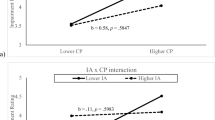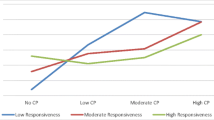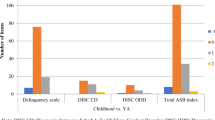Abstract
Characteristics prevalent in known child abusers and in child victims of abuse (i.e., internalizing, externalizing, sociopathy, delinquency, and nonrational conflict-solving tactics) were examined as predictors of abuse potential in adolescents. The Child Abuse Potential (CAP) Inventory (Milner, 1986) was administered to male (n = 71) and female (n = 63) teenagers attending alternative educational sites due to behavioral problems or pregnancy. Regression analyses found unique variance in abuse potential contributed by youth (16%) and teacher (6%) reports of internalizing behavior, and youth reports of sociopathy (4%) and delinquency (4%) for a total of 33% of the variance (p < .0001, n = 91) after controlling for age, sex, and pregnancy status. Number of elevated predictors in each student was also related to increased abuse potential (r = .39, p < .001). Pregnancy status and SES were not independently associated with abuse potential. Conduct disorder as a probable precursor to future abusive behavior is suggested, and the use of the CAP with adolescents is discussed.
Similar content being viewed by others
REFERENCES
Achenbach, T. (1991). Manual for the Child Behavior Checklist/4-18 and 1991 Profile Library of Congress No. 90-72107.
Allen, M., and Tarnowski, K. (1989). Depressive characteristics of physically abused children. J. Abnorm. Child Psychol. 17: 1–11.
Altemeier, W. A., O'Conner, S., Vietze, P. M., Sandler, H. M., and Sherrod, K. B. (1982). Antecedents of child abuse. J. Pediatrics 100: 823–829.
American Psychiatric Association (1994). Diagnostic and Statistical Manual of Mental Disorders 4th ed., APA, Washington, DC.
Ayoub, C., and Milner, J. S. (1985). Failure-to-thrive: Parental indicators, types, and outcomes. Child Abuse and Neglect 9: 491–499.
Baldwin, J., and Oliver, J. E. (1975). Epidemiology and family characteristics of severely abused children. Br. J. Prev. Soc. Med. 29: 205–221.
Barahal, R. M., Waterman, J., and Martin, H. P. (1981). The social cognitive development of abused children. J. Consult. Clin. Psychol. 49: 508–516.
Bayatpour, M., Wells, R., and Holford, S. (1992). Physical and sexual abuse as predictors of substance use and suicide among pregnant teenagers. J. Adolesc. Health 13: 128–132.
Biederman, J., Munir, M., and Knee, D. (1987). Conduct and oppositional disorder in clinically referred children with attention deficit disorder: A controlled family study. J. Am. Acad. Child Adolesc. Psychiatry 26: 724–727.
Belsky, J. (1993). Etiology of child maltreatment: A developmental-ecological analysis. Psychol. Bull. 14: 413–434.
Brunnquell, D., Crichton, L., and Egeland, B. (1981). Maternal personality and attitude in disturbances of childrearing. Am. J. Orthopsychiatry 51: 680–691.
Burgess, R. L., Anderson, E. A., and Schellenbach, C. J. (1981). A social interactional approach to the study of abusive families. In Vincent, J. (ed.), Advances in Family Intervention, Assessment, and Theory, Vol. 2 JAI Press, Westport, CT.
Cicchetti, D., Toth, S. L., and Hennessy, K. (1989). Research on the consequences of child maltreatment and its application to educational settings. Topics Early Child. Spec. Educ. 9(2): 33–55.
Cicchetti, D., Rogosh, F., Lynch, M., and Holt, K. (1993). Resilience in maltreated children: Processes leading to adaptive outcome. Dev. Psychopathol. 5: 629–647.
Cleckly, H. M. (1976). The Mask of Sanity 5th ed., Mosby, St. Louis.
Cohn, A., and Daro, D. (1987). Is treatment too late: What ten years of evaluative research tell us. Child Abuse and Neglect 11: 433–442.
Dembo, R., Dertke, M., La Voie, L., Borders, S., Washburn, M., and Schmeidler, J. (1987). Physical abuse, sexual victimization and illicit drug use: A structural analysis among high risk adolescents. J. Adolesc. 10: 13–33.
Elmer, E. (1967). Child abuse: The family's cry for help. J. Psychiatr. Nurs. 5: 332–341.
Friedrich, W. N., and Wheeler, K. K. (1982). The abusing parent revisited: A decade of psychological research. J. Nerv. Ment. Dis. 170: 577–587.
Garbarino, J., and Crouter, A. (1978). Defining the community context for parent-child relations: The correlates of child maltreatment. Child Dev. 49: 604–616.
Gilgun, J. (1988). Self-centeredness and the adult male perpetrator of child sexual abuse. Contemp. Family Ther. Int. J. 10(4): 216–234.
Glueck, S., and Glueck, E. (1962). Family Environment and Delinquency, Mifflin, Boston.
Haskett, M. E., Johnson, C. A., and Miller, J. W. (1994). Individual differences in risk of child abuse by adolescent mothers: Assessment in the prenatal stage. J. Child Psychol. Psychiatry Allied Disciplines 35: 461–476.
Hemenway, D., Solnick, S., and Carter, J. (1994). Child-rearing violence. Child Abuse Neglect 18: 1011–1020.
Hollingshead, A. B. (1975). Four factor index of social status. Unpublished manuscript, Yale University, New Haven, CT.
Holmes, S., and Robins, L. (1987). The influence of childhood disciplinary experience on the development of alcoholism and depression. J. Childhood Psychol. Psychiatry 28: 399–415.
Kaplan, S. J., Pelcovitz, D., Salzinger, S., and Ganeles, D. (1983). Psychopathology of parents of abused and neglected children and adolescents. J. Am. Acad. Child Psychiatry 22: 238–244.
Kazdin, A. (1992). Child and adolescent dysfunction and paths toward maladjustment: Targets for intervention. Clin. Psychol. Rev. 12: 795–817.
Kazdin, A. E. (1994). Interventions for aggressive and antisocial children. In Eron, L. D., Gentry, J. H., and Schlegal, P. (eds.) Reason to Hope: A Psychosocial Perspective on Violence & Youth, American Psychological Association, Washington, DC, pp. 341–382.
Kolko, D. J., Kazdin, A. E., Thomas, A. M., and Day, B. (1993). Heightened child physical abuse potential: Child, parent, and family dysfunction. J. Interpers. Violence 8: 169–192.
Lahey, B., Piacentini, J., McBurnett, K., Stone, P., Hartdagen, S., and Hynd, G. (1988). Psychopathology in the parents of children with conduct disorder and hyperactivity. J. Am. Acad. Child Adolesc. Psychiatry 27: 163–170.
Loeber, R., and Stouthamer-Loeber, M. (1998). Development of juvenile aggression and violence. Am. Psychol. 53: 242–259.
Main, M., and George, C. (1985). Responses of abused and disadvantaged toddlers to distress in agemates: A study in the day care setting. Dev. Psychol. 21: 407–412.
Malinosky-Rummell, R., and Hansen, D. J. (1993). Long-term consequences of childhood physical abuse. Psychol. Bull. 114: 68–79.
Marriage, K., Fine, S., Moretti, M., and Haley, G. (1986). Relationship between depression and conduct disorder in children and adolescents. J. Am. Acad. Child Psychiatry 25: 687–691.
McCarthy, J. (1990). Abusive families and character formation. Am. J. Psychoanal. 50: 181–186.
McGee, R., Feehan, M., Williams, S., Partridge, F., Silva, P., and Kelly, J. (1990). DSM-III disorders in a large sample of adolescents. J. Am. Acad. Child Adolesc. Psychiatry 29(4): 611–619.
Miller, T., Handal, P., Gilner, F., and Cross, J. (1991). The relationship of abuse and witnessing violence on the Child Abuse Potential Inventory with Black adolescents. J. Family Violence 6(4): 351–363.
Milner, J. (1986). The Child Abuse Potential Inventory Manual, 2nd ed., Psytec, Webster, NC.
Milner, J. (1994). Assessing physical child abuse risk: The Child Abuse Potential Inventory. Clin. Psychol. Rev. 14: 547–583.
Milner, J., and Ayoub, C. (1980). Evaluation of “at-risk” parents using the Child Abuse Potential Inventory. J. Clin. Psychol. 36: 945–948.
Milner, J. S., and Dopke, C. (1997). Child physical abuse: Review of offender characteristics. In Wolfe, D. A., McMahon, R., and Peters, R. dev. (eds.), Child Abuse: New Directions in Prevention and Treatment Across the Life Span, Sage, Thousand Oaks, CA, pp. 25–52.
Milner, J. S., and Williams, P. P. (1978). Child abuse and neglect: A bibliography. J. Suppl. Abstr. Serv. 8: 42 (ms. No. 1690).
Milner, J., and Wimberley, R. (1980). Prediction and explanation of child abuse. J. Clin. Psychol. 36: 875–884.
Milner, J. S., Gold, R. G., Ayoub, C., and Jacewitz, M. M. (1984). Predictive validity of the Child Abuse Potential Inventory. J. Consult. Clin. Psychol. 52: 879–884.
Newberger, E. H., Newberger, C. M., and Hampton, R. L. (1983). Child abuse: The current theory base and future research needs. J. Am. Acad. Child Adolesc. Psychiatry 22: 262–268.
Oz, S., and Fine, M. (1988). A comparison of childhood backgrounds of teenage mothers and their non-mother peers: A new formulation. J. Adolesc. 11: 251–261.
Penner, L., and Spielberger, C. (1988). Assessment of sociopathic tendencies. In Spielberger, C. D., and Butcher, J. N. (eds.), Advances in Personality Assessment, Lawrence Erlbaum Associates, Hillsdale, NJ, pp. 1–20.
Penner, L., Michael, D., and Brookmire, D. (1979). Pro-and anti-social behavior as a function of cost estimates and personality and situational variables. Multivar. Clin. Res. 4: 111–125.
Phipps-Yonas, S. (1980). Teenage pregnancy and motherhood: A review of the literature. Am. J. Orthopsychiatry 50: 403–431.
Pruitt, D., and Erickson, M. (1985). The Child Abuse Potential Inventory: A study of concurrent validity. J. Clin. Psychol. 41: 104–111.
Rausch, K., and Knutson, J. F. (1991). The self-report of personal punitive childhood experiences and those of siblings. Child Abuse Neglect 15: 29–36.
Robins, L. N. (1978). Sturdy childhood predictors of adult antisocial behavior: Replications from longitudinal studies. Psychol. Med. 8: 611–622.
Shaw-Lamphear, V. S. (1985). The impact of maltreatment on children's psychosocial adjustment: A review of the research. Child Abuse Neglect 9: 251–263.
Smith, J. A. S., and Adler, R. G. (1991). Children hospitalized with child abuse and neglect: A case control study. Child Abuse Neglect 15: 437–445.
Smith, S. M., Hanson, R., and Noble, S. (1973). Parents of battered babies: A controlled study. Br. Med. J. 4: 388–391.
Spinetta, J. J., and Rigler, D. (1972). The child-abusing parent: A psychological review. Psychol. Bull. 77: 296–304.
Straus, M. A. (1979). Measuring intrafamily conflict and violence: The Conflict Tactics Scale. J. Marriage Family. 75–88.
Straus, M. A. (1980). Stress and child abuse. In Kempe, C. H., and Helfer, R. E. (eds.), The Battered Child, 3rd ed., University of Chicago Press, Chicago, pp. 86–102.
Straus, M. A. (1995). Manual for the Conflict Tactics Scales (CTS) and test forms for the Revised Conflict Tactics Scales, Family Research Laboratory, University of New Hampshire, Durham.
Taylor, C. G., Norman, D. K., Murphy, J. M., Jellinek, M., Quinn, D., Poitrast, F. G., and Goshko, M. (1991). Diagnosed intellectual and emotional impairment among parents who seriously mistreat their children: Prevalence, type, and outcome in a court sample. Child Abuse Neglect 15: 389–401.
Twentyman, C. T., Rohrbeck, C. A., and Amish, P. L. (1985). A cognitive-behavioral model of child abuse. In Saunder, S. (ed.), Violent Individuals and Families: A Practitioner's Handbook, Charles C Thomas, Springfield, IL.
Widom, C. (1989). Does violence beget violence? A critical examination of the literature. Psychol. Bull. 106: 3–28.
Wolfe, D., and Wekerle, C. (1993). Treatment strategies for child physical abuse and neglect: A critical progress report. Clin. Psychol. Rev. 13: 473–500.
Yates, A. (1981). Narcissistic traits in certain abused children. Am. J. Orthopsychiatry 51: 55–62.
Author information
Authors and Affiliations
Corresponding author
Rights and permissions
About this article
Cite this article
Todd, M.K., Gesten, E.L. Predictors of Child Abuse Potential in At-Risk Adolescents. Journal of Family Violence 14, 417–436 (1999). https://doi.org/10.1023/A:1022886232519
Issue Date:
DOI: https://doi.org/10.1023/A:1022886232519




